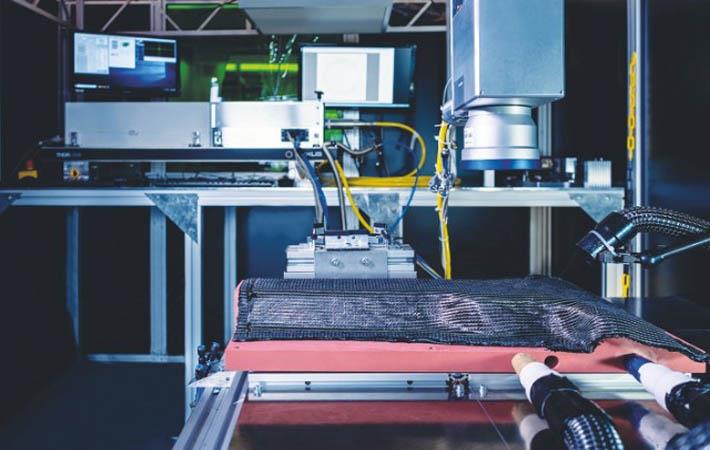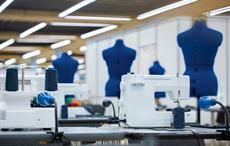Laser processes for machining composites will be at focus at the JEC World 2020 to be held in Paris from March 3 to 5. The Aachen-based Fraunhofer Institute for Laser Technology ILT will showcase laser-based processes for lightweight materials and hybrid joints. Results of testing of laser-structured and laser-bonded hybrid joints will also be presented.
Experts in composites strive to develop and research special combinations of materials for lightweight construction and other innovative applications. As the world’s leading trade fair for the composites industry, JEC World offers comprehensive insights into the entire value chain of custom material manufacturing and processing.Laser processes for machining composites will be at focus at the JEC World 2020 to be held in Paris from March 3 to 5. The Aachen-based Fraunhofer Institute for Laser Technology ILT will showcase laser-based processes for lightweight materials and hybrid joints. Results of testing of laser-structured and laser-bonded hybrid joints will also be presented. #
Fraunhofer ILT will be presenting a range of research results, including recent findings on the ageing behaviour of thermally joined metal-plastic hybrids. These multi-material designs employ a range of materials that are adapted to local loads, paving new ways to optimise component weight.
“The physical and chemical differences between the materials make it particularly challenging to join the elements together, especially when it comes to plastics and metals,” says Kira van der Straeten, scientist in the Micro Joining Group at Fraunhofer ILT. “In addition, different material properties – such as thermal expansion and corrosive infiltration – place high demands on hybrid compounds.” Assessing the ageing behaviour of the joint is therefore essential to determining the long-term stability of hybrid parts.
In cooperation with the Welding and Joining Institute (ISF) at RWTH Aachen University, partners of the AGeD project examined a range of surface pre-treatments, joining processes and material combinations and tested how these performed in hybrid joints. To obtain information on the long-term stability, the team conducted climate change tests and corrosion tests on hybrid joints consisting of various metals and combinations of plastics.
The results of tensile shear tests conducted before and after the alternating-climate testing of laser-structured and laser-bonded hybrid joints revealed no significant reduction in bond strength. Equally, there was no detectable negative influence on the tensile shear strength of the joints subsequent to corrosion testing. Straeten summed up the results of the project, which was commissioned by Germany’s federal ministry for economic affairs and energy (BMWi): “The results show that this method has a clear competitive advantage compared to other joining methods and that it is perfectly suited to a whole range of different plastic-metal hybrid joints.” Offering good long-term stability under a wide range of environmental influences, this technique is a particularly good choice for applications in the automotive and aerospace industries.
Together with the Institute for Plastics Processing (IKV) in Industry and Craft at RWTH Aachen University, Fraunhofer ILT has developed a dedicated method of joining plastics to magnesium sheets. At the JEC fair, the researchers from Aachen will be showcasing how injection molding and laser microstructuring can be used to produce extremely lightweight parts.
This method involves using fibre laser radiation to microstructure magnesium sheets in an argon atmosphere. The sheets are then placed in an injection molding tool and the plastic is bonded to the magnesium sheet by means of a special injection molding process in which the molten plastic fills the microstructures to form an adhesive bond. Thanks to this form fit, even chemically different materials can be easily joined together.
Tests have shown that this method can achieve tensile shear strengths of over 28 MPa through modifications to the structural geometry and layout. These values are significantly higher than the standard strengths for structural bonds in joining processes based on adhesion agents, which are generally in the region of 10 MPa.
The Aachen-based scientists will also be taking the opportunity of the Paris fair to demonstrate how a robot-guided ultrashort pulsed (USP) laser can be used as an efficient and reliable tool for drilling 3D-formed CFRP preforms. Five project partners from research and industry joined forces as part of the publicly funded CarboLase project to create a robot cell with an automated process chain to manufacture laser-machined preforms at the Institut für Textiltechnik (ITA) at RWTH Aachen University.
The USP laser beam is guided through a hollow core fibre from the beam source to a galvo scanner on the articulated robot arm. Thanks to the stabilised laser beam, the beam guidance system – which uses no mirrors – can easily follow the highly dynamic movements of the scanner across the CFRP preform. The benefits of precise, zero-defect laser ablation allow the robot-guided USP laser to drill perfectly proportioned holes for inserts and other purposes. What’s more, the final matrix infusion used in this method produces a reliable multi-material connection on a consistent basis even without an adhesive. In tests conducted in the CarboLase project, the inserts bonded directly to the matrix material achieved a maximum pull-out force that was up to 50 per cent higher than that of conventionally manufactured components with glued-in inserts.
“The dynamic USP laser drilling process is particularly beneficial for lightweight parts used in aviation and automotive engineering,” says Stefan Janssen, scientist in the Micro and Nano Structuring Group at Fraunhofer ILT. “The process is easy to automate and produces stronger connecting elements. This can potentially cut costs and reduce the amount of material required to manufacture CFRP components.”
Fibre2Fashion News Desk (SV)


